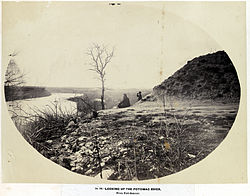| Fort Sumner | |
|---|---|
| Part of the Civil War Defenses of Washington | |
| Montgomery County, Maryland | |
 View of the Potomac River from Fort Sumner | |
| Site information | |
| Type | Earthwork fort |
| Controlled by | Union Army |
| Condition | Residential area |
| Location | |
| Coordinates | 38°57′19″N77°07′26″W / 38.9554°N 77.1240°W |
| Site history | |
| Built | 1861 |
| Built by | U.S. Army Corps of Engineers |
| In use | 1861–1865 |
| Materials | Earth, timber |
| Demolished | 1953 |
| Battles/wars | American Civil War |
Fort Sumner was built during the American Civil War by the Union Army in the Brookmont section of Bethesda, Maryland, just northwest of Washington, D.C.



